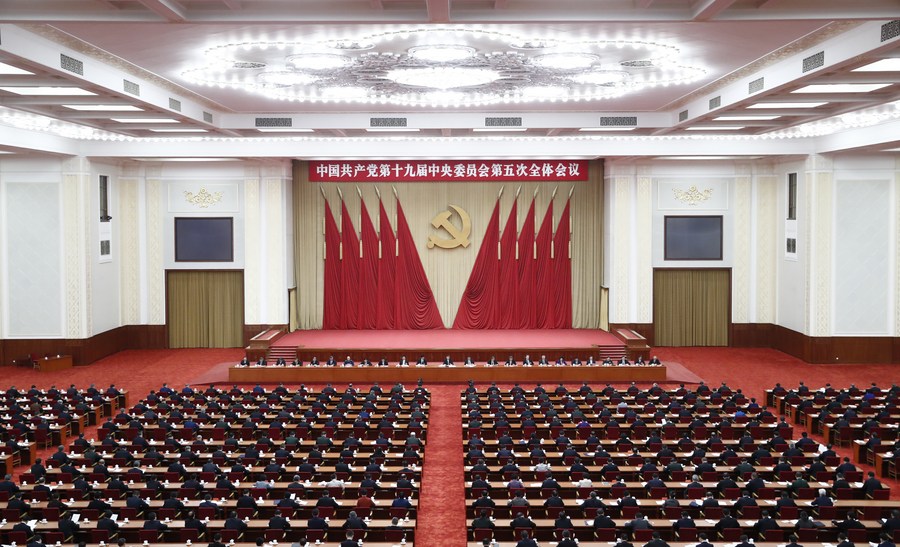


Xi Jinping, general secretary of the Communist Party of China(CPC) Central Committee, makes an important speech at the fifth plenary session of the 19th CPC Central Committee in Beijing, capital of China. The session was held in Beijing from Oct. 26 to 29, 2020. (Xinhua/Ju Peng)
BEIJING, Nov. 5 (Xinhua) -- The Communist Party of China (CPC) on Tuesday unveiled in full text the Party leadership's proposals for formulating the 14th Five-Year Plan (2021-2025) for National Economic and Social Development and the Long-Range Objectives Through the Year 2035.
It is a major document to guide the development of the world's second-largest economy for the next five to 15 years.
So, how was it drafted? According to people familiar with the drafting, the process featured both top-level design and public opinions.
The process officially kicked off on April 13 when a drafting group headed by Xi Jinping, general secretary of the CPC Central Committee, held its first plenary meeting.
At the meeting, Xi highlighted 38 important issues for the drafting group to begin with. Two days later, the group swung into action in full throttle.
On June 17, Xi convened the group's second plenary meeting, where the structure of the document was discussed.
Shedding light on the document's title, Xi said combining the five-year plan and the long-range objectives through 2035 will give the document a stronger sense of direction, as well as historical and strategic importance.
Taking the details into consideration, Xi divided the group into task divisions and proposed seven specific highlights for the draft, including placing an emphasis on doing China's own things well, upholding reform and opening-up, and prioritizing technological innovation.
Xi stressed the importance of hearing people's voices. On Sept. 17, he presided over a meeting with grassroots representatives and talked with the speakers from a broad spectrum of professions: rural teacher, migrant worker, truck driver, etc.

The fifth plenary session of the 19th Central Committee of the Communist Party of China (CPC) is held in Beijing, capital of China, from Oct. 26 to 29, 2020. (Xinhua/Liu Bin)
Between July and September, Xi presided over seven symposiums to solicit opinions and suggestions from entrepreneurs, non-CPC personages, experts in economic and social fields, scientists as well as experts in education, culture, health and sports.
Comments were also solicited online, and in just two weeks, over 1 million pieces of comments were collected.
Xi asked relevant departments to sort, analyze and absorb the comments, and urged further efforts to use the internet to listen to the people's voices.
"The task of collecting suggestions for the development plan proposals has been unprecedentedly extensive," said a member of the drafting group.
Xi convened a series of high-level meetings, including three meetings of the Standing Committee of the Political Bureau of the CPC Central Committee and two meetings of the Political Bureau of the CPC Central Committee, to review the draft document, before it was submitted to the fifth plenary session of the 19th CPC Central Committee.
On Oct. 26, Xi made an explanatory speech on the draft to the session before deliberation started. Almost all attendees spoke during the discussions, putting forward more than 290 suggestions.
Based on their opinions, the drafting group made 31 modifications.
In the evening of Oct. 28, Xi presided over a meeting of the Standing Committee of the Political Bureau of the CPC Central Committee to review the revised draft.
The next morning, the revised draft was submitted to the session for another deliberation, and the drafting group made modifications according to new suggestions of the attendees.
The document was finally adopted in the afternoon of Oct. 29.
Xi said the document will serve as a guide for China's development course in the next five years and beyond. "It is a guiding document for the march toward the second centenary goal," he added.

 Award-winning photos show poverty reduction achievements in NE China's Jilin province
Award-winning photos show poverty reduction achievements in NE China's Jilin province People dance to greet advent of New Year in Ameiqituo Town, Guizhou
People dance to greet advent of New Year in Ameiqituo Town, Guizhou Fire brigade in Shanghai holds group wedding
Fire brigade in Shanghai holds group wedding Tourists enjoy ice sculptures in Datan Town, north China
Tourists enjoy ice sculptures in Datan Town, north China Sunset scenery of Dayan Pagoda in Xi'an
Sunset scenery of Dayan Pagoda in Xi'an Tourists have fun at scenic spot in Nanlong Town, NW China
Tourists have fun at scenic spot in Nanlong Town, NW China Harbin attracts tourists by making best use of ice in winter
Harbin attracts tourists by making best use of ice in winter In pics: FIS Alpine Ski Women's World Cup Slalom
In pics: FIS Alpine Ski Women's World Cup Slalom Black-necked cranes rest at reservoir in Lhunzhub County, Lhasa
Black-necked cranes rest at reservoir in Lhunzhub County, Lhasa China's FAST telescope will be available to foreign scientists in April
China's FAST telescope will be available to foreign scientists in April